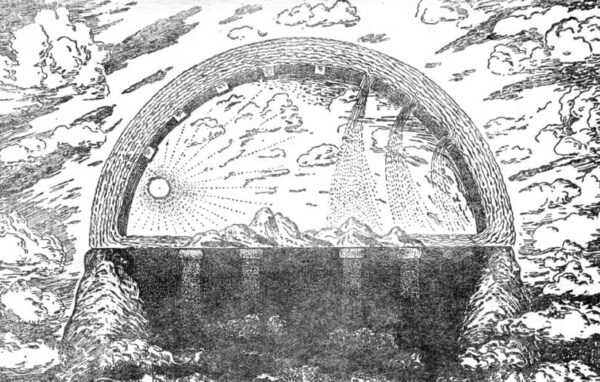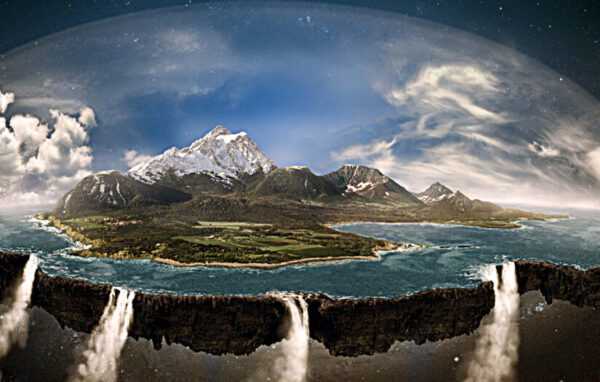1.The views of the thinkers of the ancient world on the structure of the universe
The mystery of the origin of the Universe has always worried humanity. Many theories and hypotheses, presented by the best minds of our civilization, offered all kinds of options for the origin of the World.
The first ideas about the universe began to appear in the views of the thinkers of Mesopotamia, ancient Egyptian mythology, the texts of scientists of ancient India and in the schools of thought of ancient Greece. Of course, for philosophers and astronomers of that time, understanding of the universe was limited to what they could see with their own eyes. Therefore, the Earth, as a rule, was in its center and was the basis of the Universe.
The views of the thinkers of the ancient world on the structure of the universe
Sumerians. Mesopotamia
The first mention of the Universe was found in the 4th millennium BC in Mesopotamia among the ancient Sumerians. The cosmological concept of the Sumerian thinkers about the world around us was associated with the primordial ocean in which the universe was formed.
The ocean was the root cause of its origin. The main components, according to the views of the Sumerian philosophers, were earth and sky. At the same time, the earth seemed to them as a huge flat disk, over which the celestial dome towered.
It should be noted that the very concept of “Universe” did not exist among the Sumerians. They viewed it as a natural combination of earth and sky. The basis, in their opinion, was water. From the water came the earth and the sky. The Universe itself was motionless and was in the endless ocean surrounding it from all sides.
Scientists-philosophers of Mesopotamia speculated about the solar system, made lists of planets and described their characteristics, talked about the moon and the stars. They identified the cosmos with the Universe.
Ancient babylon
The views of the Sumerian philosophers became the basis for the ancient Babylonians’ ideas about the universe. Just like the Sumerians, the Babylonian sages believed that the universe consists of earth and sky. They envisioned the land as a huge mountain surrounded by the sea. The heavenly world was located above the earth. This world included the belt of the celestial constellations, represented by the twelve signs of the zodiac.
The thinkers of Babylon closely linked life on earth with the movement of stars and planets, therefore astronomy and astrology were actively developing. The main astrologers were the priests. Priests-astrologers learned to predict the future, calculate the time of solar eclipses and the movement of heavenly bodies, and distinguish stars from planets. They introduced a calendar system of 12 months, introduced the concepts of “week”, “hour”, “minute”. We still use this system, in a refined form.
Babylonian astronomers noticed that the sun stays in each constellation for about one month. According to their beliefs, the Sun descends every evening into the depths of the sea and passes through the underground in which hell is located. In the morning it leaves the underworld and rises above the Earth again.
Ancient Jews
Babylonian astronomy influenced the development of the views of the Hebrew sages. Studying the world around them, observing the movement of the moon and celestial events, they created their own lunisolar calendar.

The ancient Jews considered the Earth a plain because the Semitic peoples themselves lived on a plain. Mountains towered around. The sky, according to the Talmud, is solid and permeated with holes in the firmament. Through them, the clouds are filled with water from the vault above the sky and then irrigate the earth, feed the rivers and seas.
The winds cause both rain and drought. They are located in the lower part of the sky, which separates the earth from the heavenly water. During the day, the sun moves across the sky to the place of sunset, and in the evening, according to different interpretations, it returns to the place of sunrise, passing either above the sky or underground.
Ancient Egypt
The subject of the Sun, naturally, was constantly in the center of attention of philosophers and astronomers of antiquity. The Egyptians believed that there are two main rivers on Earth: the heavenly and the underground. The Heavenly River flows from east to west. On it, the Sun God Ra floats across the sky from morning to evening, in order to return at night along the underground river.

The Egyptians envisioned the world as a combination of Heaven, Earth and Sun. The earth is below, above it stretches the sky, personified by the Goddess of Heaven. The Sun God ship moves across the sky from sunrise to sunset. The universe was considered a huge valley, in the center of which is Egypt. The sky was depicted as a metal roof, from which stars and planets are suspended.
Ancient India
Early Indian astronomy is also closely related to religion. In II – I millennia BC. in the Vedas, information was collected about solar eclipses, the frequency of the appearance of the moon, the priority of the Earth and the Sun in the Universe. According to Vedic concepts, the universe is a huge egg. There are a lot of universes and they float like bubbles in the Primary Ocean.
The ancient Indians believed that the Earth was a flat disk that rests on the backs of fantastically huge elephants. Elephants stand on the shell of a giant tortoise that sits on top of a snake. The snake represents the sky. It closes the entire earthly space.
Ancient China
In ancient China, it was believed that the universe was like an egg split in half. The upper part of the egg forms the firmament, and the lower part of the egg is the Earth floating in the world’s oceans.
According to the ideas of the ancient Chinese, the primary world consists of “qi” (sometimes “chi”) – the smallest living particles, chaotically scattered throughout the universe. These particles are divided into heavy and dark – “Yin”, as well as light and light – “Yang”.
The titan Pan-gu, who emerged from the universal egg, was considered the creator of the surrounding world. It was he who divided the particles into Yin and Yang. Yin, as the heavier ones, fell down and formed the earth, and the Yang formed the sky. So Pan-gu separated the earth from the sky.

The entire surrounding world arose as a result of the interaction of Yin and Yang. This is how the primary elements appeared: Fire, Metal, Earth, Water and Wood, which became the constituent elements of everything that exists. Later, the goddess Nuiwa created humans.
Ancient Greeks
The ancient Greeks imagined the change of day and night similar to the Egyptians. The ancient Greek myth differed from the Egyptian one only in that among the Greeks the sun god named Helios did not sail on a ship on a heavenly river, but rode in a chariot.
However, soon such primitive myths ceased to suit the scientists of Hellas. Already in the IX-VIII centuries. BC e. in the poems of the ancient Greek poet Homer “Iliad” and “Odyssey” it is said that the Earth is a slightly convex disk, reminiscent of a warrior’s shield. On all sides the land is washed by the Ocean River. Above the Earth is a copper firmament, along which the Sun moves, rising daily from the waters of the Ocean in the east and plunging into them in the west.
From simple contemplative ideas about the universe, the philosophers of ancient Greece tried to move on to more scientific explanations of the structure of the world. The founder of Greek scientific philosophy and cosmology in the VI-V centuries. BC. considered the ancient Greek philosopher and mathematician Thales of Miletus.
Scientists of Ancient Greece
Thales of Miletus
Thales of Miletus (640/624 – 548/545 BC) founded the Milesian natural-philosophical school, which studied philosophy, mathematics, astronomy, Greek culture and government.
Thales came from a noble and wealthy family, so he had the opportunity to get a good education and travel. He visited the ancient Jewish sages in Babylon and the priests in Egypt.
There he underwent training and was carried away by the knowledge of the Universe and the world around us.
Thales of Miletus considered water to be the fundamental principle of the world, by which he understood the single substance of the entire universe.
He argued that everything is created from water and everything is transformed into it. Everything arises on its basis by thickening and rarefaction. This substance (water) is primary matter, it is infinite in space, the Universe and the entire world around us are created from it. And if water is infinite, then the Universe is also infinite in its development and functioning.
The cosmos in his view was one, and water and everything that came from it are not dead, but animate. According to Thales, all nature, living and inanimate, has a soul. The Earth is located in the center of the Universe and floats in the water of the World Ocean. The sun and all the stars are made of earth and are hot. Therefore, they glow.
The moon is also made of earth, but it is cold. Thales was the first to guess that the Moon shines with reflected light and that it darkens the Sun during a solar eclipse.
Thales suggested using the constellation Ursa Minor as a guiding tool for travelers and sailors. He learned to determine the time of the equinoxes and solstices, the inclination of the ecliptic to the equator, the angular size of the Sun and Moon. Introduced an annual calendar of 12 months and 365 days according to the Egyptian model.
Thales himself led a very modest and secluded life. He actively promoted science among his fellow citizens. Once, in order to show what benefits the knowledge of astronomy can give, he, foreseeing a large harvest of olives, rented in advance all the oil presses in Miletus and Chios. Nobody believed in the harvest of olives, so the prices for the oil press were very low. When fellow citizens reaped a really rich harvest, everyone came to Thales and rented an oil press from him, but, naturally, at a higher price.
This brought Thales a lot of money. However, his goal was not money, but recognition of the need to study the sciences. Thales’ best student was the philosopher Anaximander, who became a teacher for the thinker Anaximenes.
Anaximander of Miletus
Anaximander of Miletus (610 – 547/542 BC) – the ancient Greek philosopher introduced the term “law”, formulated the first concept of the law of conservation of matter, made the first map of the Earth, invented the first sundial.
According to Anaximander, the Earth is in the center of the world. Above it, a water and air shell is formed, and above them, a shell of fire. There are holes in the air envelope through which light breaks through. People take this light for luminaries. The largest hole emits the brightest light and is called the Sun. Anaximander believed that there are many worlds in the universe.
Anaximenes of Miletus
Anaximenes of Miletus (585/560 – 525/502 BC) – Ancient Greek philosopher and disciple of Anaximander. He considered air to be the fundamental principle of the world. The whole world arose out of thin air.
It is diverse because the air is in different states. Thin air gives rise to fire and heavenly bodies, and dense air gives rise to water, earth and stones. Underpressure, according to Anaximenes, is associated with heating, and compaction with cooling. From the air “everything arises and everything returns to it”.
Pythagoras of Samos
The first assumptions that all space objects have the shape of a ball, in the VI century BC. expressed by the philosopher and mathematician Pythagoras of Samos (570-490 BC). From a young age, Pythagoras traveled, gained wisdom and knowledge.
In ancient Greece, he studied the basics of music, painting, rhetoric, grammar. Pythagoras constantly developed his memory and logical abilities. On the island of Lesvos, he devoted time to physics, dialectics, astrology and medicine. At the Miletus school, Pythagoras studied philosophy, astronomy and mathematics from Thales himself.
At 18, he went to Egypt, where he studied medicine, mathematics and astronomy with the priests. The priests introduced him to secret knowledge and Egyptian traditions. Soon Pythagoras himself received the rank of priest. He was a prisoner in Babylon, but there he also communicated with magicians and studied medicine, astronomy and arithmetic. Traveling and studying sciences, he spent a total of 34 years and became the most educated person of that time.
Pythagoras was the first to call the Universe Cosmos and created the doctrine of Cosmos. The Universe and the Earth, in Pythagoras’s view, have a spherical shape. The spherical universe contains concentric crystal spheres nested inside each other, to which stars and planets are attached. The center of this crystal universal miracle is filled with fire. The sun is only a reflection of this fire. The sun, moon and all the planets of the solar system revolve around the earth.
Plato
Another ancient Greek philosopher Plato (428/427 – 348/347 BC), discussing the cosmos in the Dialogues “Timaeus”, believed that “the cosmos is a living being, endowed with a soul and mind”, born “with the help of the divine Providence. ” For tens of centuries before the advent of our era, Plato believed that God created the universe from the ether.
Aristotle
A student of Plato and educator of Alexander the Great, the philosopher Aristotle (384 – 322 BC) created a cosmological system that had a huge impact on the further development of views and ideas about the Universe.
Aristotle suggested that the Earth, Moon and all celestial bodies have a spherical shape. He argued that the stars are composed of ether – the imperishable “most perfect element of nature.” Ether is a transfer medium for light and heat arising on the Sun. Aristotle, Plato and many Pythagoreans adhered to the geocentric system of the world, which believes that the Earth is at the center of the universe.
Heraclitus of Pontus
The ancient Greek philosopher and astronomer Heraclitus of Pontus (387 -312 BC) put forward the idea of the Earth’s rotation around its axis, explaining this by the daily rotation of the celestial sphere. He believed that “each star represents the world, including earth, air, ether” and all this is in the infinite ether. Heraclitus denied the existence of absolute emptiness and believed that the world is filled with the finest substance – ether.
Aristarchus of Samos
It took about a hundred years before the ancient Greek astronomer and mathematician Aristarchus of Samos (c. 310 – c. 230 BC) first proposed a heliocentric system of the world, suggesting that the Sun is the central celestial body around which the Earth revolves and others planets.
However, he believed that the Universe is a limited space with stars stationary in relation to the Sun. Aristarchus worked on determining the distances from the Earth to the Moon and to the Sun, applied the scientific method to calculate their sizes.
Unlike his predecessors, he considered the Sun to be the center of the Universe. This statement of Aristarchus of Samos was undoubtedly revolutionary. It was contrary to conventional wisdom. Unfortunately, the philosopher did not have enough scientific arguments and there were no serious like-minded people who could support him. Therefore, his heliocentric system of the world did not find support among his contemporaries and was developed only after 1800 years in the works of N. Copernicus.
The views of Plato and Aristotle, their geocentric model of the world, were developed almost 500 years later by the ancient Greek astronomer, mathematician, optician and geographer Claudius Ptolemy (c. 100 – c. 170). Around A.D. 140 e. in his classic work “Almagest” Claudius Ptolemy collected all the astronomical knowledge of the thinkers and astronomers of Greece and the Middle East.
Claudius Ptolemy
Ptolemy’s views developed the theoretical views of Aristotle. In his work, Claudius outlined a vision of the geocentric system of the world. According to him, the Earth is at the center of the universe. All celestial bodies, including the Sun, revolve around the Earth. The Earth is a ball and it is motionless, and solid celestial transparent spheres with luminaries attached to them revolve around it. The universe is not infinite, it has boundaries that are determined by the sphere of fixed stars. In the Almagest, Ptolemy presented a catalog of the starry sky of 48 constellations.
Having made a number of calculations, Ptolemy was able to imagine the unevenness of the motion of heavenly bodies and planets in orbits. Ptolemy’s theory was accepted by the scientific world and existed until the beginning of the 16th century.
In their understanding, the Earth was in the center of the Universe and the Cosmos and looked like a huge flat disk resting on the backs of elephants, turtles or whales. However, in the later reflections of philosophers, there were suggestions that the Earth has a spherical shape.
Usually thinkers came to this, who happened to wander the seas and they could visually assess the sphericity of the sky and the sea. It is important to note that they did not have instruments and devices for a deep study of the world around them that would be more perfect than their own vision. This did not allow them to look into the depths and beyond the solar system for a detailed understanding of reality. Therefore, the knowledge of the thinkers and astronomers of the Ancient world was more of an applied nature.
It should be noted that philosophers and astronomers of the Ancient World have always thought about where we live, how, by whom and from what our world was created. They were interested in what place our planet occupies in the Universe.
They collected, created and analyzed the primary knowledge about the Earth, about the planets and stars, about the structure of the solar system, about the Universe and Space. Despite the fact that this knowledge was naive in nature, it became the basis for the development of medieval views on the structure of the world.
Timur Timerbulatov President of the Conti group of companies, scientist, academician of the Russian Academy of Natural Sciences, writer (literary pseudonym Mon Tirey)



